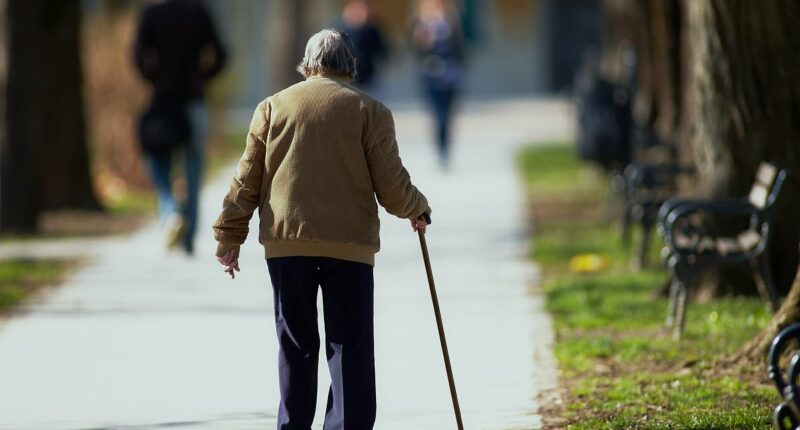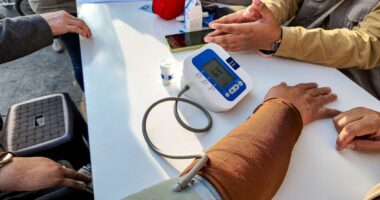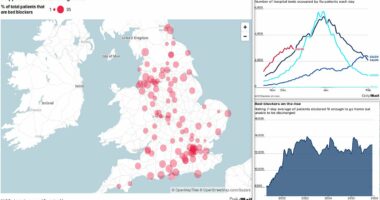Share this @internewscast.com
A recent study has unveiled a promising new method for detecting Parkinson’s disease almost nine years prior to its official diagnosis. By observing how quickly individuals turn around while walking, researchers can identify early signs of this neurodegenerative disorder.
Parkinson’s disease is a progressive condition that gradually damages parts of the brain, often taking years before any noticeable symptoms appear. Those affected typically experience worsening tremors and movement difficulties, ultimately impacting their autonomy and quality of life.
For many years, scientists have emphasized the importance of identifying the disease during its early stages, known as the prodromal phase. However, creating a reliable test to detect Parkinson’s long before symptoms manifest has proven challenging.
In a significant breakthrough, neurologists from Germany have revealed that difficulties in turning while walking could serve as an early indicator of Parkinson’s, nearly 8.8 years before a formal diagnosis is made.
The findings, published in the journal Annals of Neurology, highlight that turning is a complex component of walking. It necessitates ongoing coordination and adjustment of one’s movement path, an aspect that could provide critical insights into early disease detection.
Writing in the journal Annals of Neurology, they said: ‘Turning is a complex part of walking. It requires constant coordination, and modification of the locomotor trajectory while moving.
‘Difficulties turning are common and highly relevant to daily life in Parkinson’s.
‘Therefore, it seems intuitive that turning deficits could be observed, emphasising the need to investigate the predictive potential of turning measures in this phase.’

The researchers found that turning more slowly at a wider angle whilst walking was associated with an increased risk of Parkinson’s
In the study, researchers analysed the movement patterns of 924 participants over the age of 50 without significant hearing of visual impairments from the Tübingen Evaluation of Risk Factors for Early Detection of Neurodegeneration (TREND) study.
Participants completed the test five times over a 10-year period, which involved walking a 20m long hallway for one minute at their preferred pace, with a wearable tracker on their lower back.
The researchers found that slower turning at baseline was associated with a higher risk of Parkinson’s diagnosis, with deviations from controls emerging almost 9 years before diagnosis.
By the end of the study, 23 participants were diagnosed with the disease, around five years after baseline tests were completed.
Using machine-based learning which accounted for age, sex, and the top speed participants were turning at, researchers were able to successfully identify 60 per cent of patients in the early stages of Parkinson’s.
Participants tended to turn more slowly as they aged, with those who went on to receive a Parkinson’s diagnosis starting to turn more slowly at a wider angle up to 8.8 years before official diagnosis.
This, the experts suggests, may be a sign of deterioration either in general speed of movement or in balance and postural stability—both of which are very often affected by Parkinson’s.
They added: ‘A decline in postural stability may subconsciously incentivise patients to turn slower and adopts a safer route, using a larger arc.
‘This would mean that Parkinson’s patients—who are already in the prediagnosistc phase—develop strategies for safer and more stable turning.’
Interestingly, men were found to be at an increased risk of developing the disease, whilst every 1-year increase of age was associated with a 15 per cent increased risk of Parkinson’s.
According to the study, men were four times more likely to develop the disease than women.
The researchers concluded: ‘Our results suggest that turning measures may aid in predicting the clinical Parkinson’s diagnosis and enhance a panel of prediagnostic markers for identifying high-risk indiciauls.
‘Using a single wearable inertial measurement unit and validated algorithms, the approach used in this study, is practical for large-scale screening for Parkinson’s.’
Whilst this is the first prospective longitudinal study to assess turning measures in Parkinson’s the researchers acknowledged that their study had a number of limitations and drawbacks—such as only including seven tuning measures.
‘Future work can investigate more turning characteristics, also in combination with gait and balance characteristics’, the researchers posited.
A larger sample size would also provide more generalisable results they said.
Currently there is no definitive test for the devastating condition, with diagnosis usually based on the development of later stage symptoms like tremors after other potential health conditions have been ruled out.
Parkinson’s charities estimate over one in four patients with the condition are misdiagnosed before getting the correct diagnosis.
Parkinson’s is currently thought to affect around 153,00 people living in the UK and 500,000 Americans—but a new study published last month revealed that more than 20,000 people in Britain could unknowingly be living with the disease.
Every hour, two people are diagnosed with the condition in the UK and the disease costs the NHS more than £725million a year.
Early signs of Parkinson’s include a tremor, stiffness, slowness of movement and loss of smell.
Balance problems such as issues with coordination and muscle cramps are other common signs.
Patients can also, as a consequence of their disease, frequently suffer from mental health problems like depression and anxiety.
Parkinson’s is caused by the death of nerve cells in the brain that produce dopamine, a chemicals which controls movement but experts are still working to uncover what triggers the death of these nerves.
Current thinking is that it’s due to a combination of genetic changes and environmental factors.
Risk of developing the condition broadly increases with age, with most patients are diagnosed over 50.













